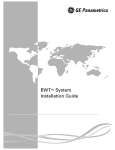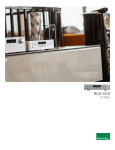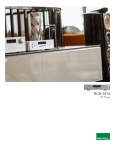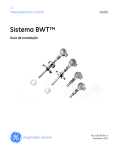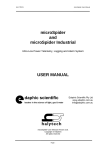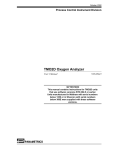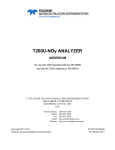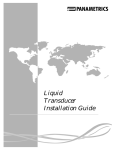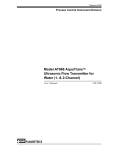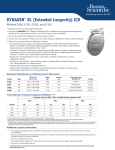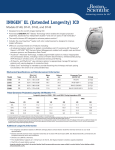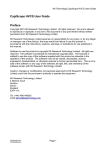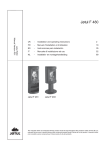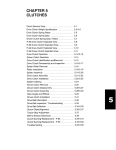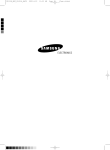Download BWT System Installation Guide
Transcript
BWT TM System Installation Guide February 2002 Process Control Instrument Division BWTTM System Installation Guide User’s Guide 916-058A February 2002 Table of Contents Chapter 1: General Information Introduction . . . . . . . . . . . . . . . . . . . . . . . . . . . . . . . . . . . . . . . . . . . . . . . . . . . . . . . . . . . . . . . . . .1-1 Types of BWT Buffers. . . . . . . . . . . . . . . . . . . . . . . . . . . . . . . . . . . . . . . . . . . . . . . . . . . . . . . . . . 1-1 General Guidelines for Transducer Position and Location . . . . . . . . . . . . . . . . . . . . . . . . . . . . . . 1-2 BWT Flowcells . . . . . . . . . . . . . . . . . . . . . . . . . . . . . . . . . . . . . . . . . . . . . . . . . . . . . . . . . . . . . . . 1-3 Single-Traverse Flowcells. . . . . . . . . . . . . . . . . . . . . . . . . . . . . . . . . . . . . . . . . . . . . . . . . . . . 1-3 Multiple-Traverse Flowcells . . . . . . . . . . . . . . . . . . . . . . . . . . . . . . . . . . . . . . . . . . . . . . . . . . 1-4 Handling and Installing a Spoolpiece . . . . . . . . . . . . . . . . . . . . . . . . . . . . . . . . . . . . . . . . . . . . . . 1-5 Unpacking a Spoolpiece . . . . . . . . . . . . . . . . . . . . . . . . . . . . . . . . . . . . . . . . . . . . . . . . . . . . . 1-5 Installing a Spoolpiece . . . . . . . . . . . . . . . . . . . . . . . . . . . . . . . . . . . . . . . . . . . . . . . . . . . . . . 1-5 Welding Requirements. . . . . . . . . . . . . . . . . . . . . . . . . . . . . . . . . . . . . . . . . . . . . . . . . . . . . . . . . . 1-6 Spoolpiece Requirements When Flushing. . . . . . . . . . . . . . . . . . . . . . . . . . . . . . . . . . . . . . . . . . . 1-7 Chapter 2: Installing Standard BWT Buffers (FTPA) and Transducers Identifying and Checking Components . . . . . . . . . . . . . . . . . . . . . . . . . . . . . . . . . . . . . . . . . . . . . Assembling the Standard BWT Buffer . . . . . . . . . . . . . . . . . . . . . . . . . . . . . . . . . . . . . . . . . . . . . Inserting the Standard BWT Buffer. . . . . . . . . . . . . . . . . . . . . . . . . . . . . . . . . . . . . . . . . . . . . . . . Torquing the Studs. . . . . . . . . . . . . . . . . . . . . . . . . . . . . . . . . . . . . . . . . . . . . . . . . . . . . . . . . . . . . Installing the BWT Transducer . . . . . . . . . . . . . . . . . . . . . . . . . . . . . . . . . . . . . . . . . . . . . . . . . . . 2-1 2-3 2-4 2-6 2-9 Chapter 3: Installing Acoustic Isolation BWT Buffers (FIPA) and Transducers Identifying and Checking Components . . . . . . . . . . . . . . . . . . . . . . . . . . . . . . . . . . . . . . . . . . . . . 3-1 Inserting the Acoustic Isolation BWT Buffer . . . . . . . . . . . . . . . . . . . . . . . . . . . . . . . . . . . . . . . . 3-3 Torquing the Studs. . . . . . . . . . . . . . . . . . . . . . . . . . . . . . . . . . . . . . . . . . . . . . . . . . . . . . . . . . . . . 3-7 Installing the BWT Transducer . . . . . . . . . . . . . . . . . . . . . . . . . . . . . . . . . . . . . . . . . . . . . . . . . . 3-11 Installing Additional Acoustic Isolation . . . . . . . . . . . . . . . . . . . . . . . . . . . . . . . . . . . . . . . . . . . 3-13 Chapter 4: Installing Non-Flanged BWT Buffers (FSPA) and Transducers Installing Non-Flanged BWT Buffers and Transducers . . . . . . . . . . . . . . . . . . . . . . . . . . . . . . . . 4-1 i Chapter 1 General Information Introduction . . . . . . . . . . . . . . . . . . . . . . . . . . . . . . . . . . . . . . . . . . .1-1 Types of BWT Buffers . . . . . . . . . . . . . . . . . . . . . . . . . . . . . . . . . . .1-1 General Guidelines for Transducer Position and Location . . . . . 1-2 BWT Flowcells . . . . . . . . . . . . . . . . . . . . . . . . . . . . . . . . . . . . . . . . .1-3 Handling and Installing a Spoolpiece. . . . . . . . . . . . . . . . . . . . . . .1-5 Welding Requirements . . . . . . . . . . . . . . . . . . . . . . . . . . . . . . . . . .1-6 Spoolpiece Requirements When Flushing . . . . . . . . . . . . . . . . . .1-7 February 2002 Introduction Installing the BWTTM System consists of creating a flowcell, installing the transducer buffer, and then mounting transducers into the buffer. Panametrics offers a variety of buffers and flowcells for your application. This sections consists of general information for the following: • • • • • • Types of BWT Buffers General Guidelines for Transducer Position and Location BWT Flowcells Handling and Installing a Spoolpiece Welding Requirements Spoolpiece Requirements when Flushing Refer to the appropriate section of this manual to install the BWT buffers and transducers that you ordered. Types of BWT Buffers Buffers are used to protect the BWT transducers from temperature extremes. Since they mount directly into the pipe coupling or nozzle, they also act as barriers against the process, making it possible for the transducers to be removed without interrupting the process or emptying the pipe. There are three BWT buffer types available for transducers for liquid and gas applications: • Standard BWT Buffer (part number FTPA) - is used for liquid and gas applications. The buffer has a flanged process connection and is available in two lengths: 2 in. (temperatures up to 600oF/315oC) and 6 in. (temperatures up to 1,100oF/600oC). • Acoustic Isolation BWT Buffer (part number FIPA) - is used for gas applications at lower pressures. The buffer has a flanged isolation section that reduces acoustic short circuit. The buffer has a flanged process connection and is available in two lengths: 2 in. (temperatures up to 600oF/315oC) and 6 in. (temperatures up to 1,100oF/600oC). • General Information Non-Flanged BWT Buffer (part number FSPA) - is used in liquid applications and has a 1 in. NPT thread or socket-weld connection. 1-1 February 2002 General Guidelines for Transducer Position and Location Whichever transducer type is selected for your installation, flowmeter accuracy depends on proper transducer location, spacing, alignment, and electronics programming. However, even though every transducer installation has specific location considerations, the following location guidelines apply to all transducers, regardless of type: Caution! A flowmeter’s accuracy and performance depends on the location, spacing, and alignment of the transducers. The specific spacing of your transducers are unique to your installation. 1. To help assure a uniform flow profile, locate the flowcell so that there are at least 10 pipe diameters of straight, undisturbed flow upstream and 5 pipe diameters of straight, undisturbed flow downstream from the point of measurement. Measure the distance from the center of the transducer at the pipe wall ID. “Undisturbed flow” means avoiding sources of turbulence such as valves, flanges, elbows; avoiding swirl; and avoiding cavitation. 2. It is important to locate the transducers on a horizontal plane. This specifically applies to mounting transducers on a horizontal pipe. One transducer cannot be on top of the pipe and one on the bottom, because the top of the pipe tends to accumulate gas and the bottom tends to accumulate sediment. These contaminants can attenuate or block the ultrasonic signal. There is no similar restriction with vertical pipes. To ensure a full pipe, however, you should avoid vertical downward flow. When using a wetted installation, extended-well type transducers are preferred to keep the transducer face free from gas or sediment that may tend to get trapped in the transducer port. 1-2 General Information February 2002 BWT Flowcells BWT installations typically use a tilted-diameter flowcell. A tilteddiameter flowcell is so named because the transducers send their pulses at a 45o angle across the diameter (or other chord) of the pipe. This type of flowcell can be configured as a single-traverse or multiple-traverse installation. Note: The mounting angle for the transducer is typically 45°, but other angles (20°, 30°, or 60°) can be used as required. Tilted diameter can also refer to paths that are off-diameter such as the mid-radius path. A flowcell is created by mounting the nozzles on the existing pipeline, or on a spoolpiece. A spoolpiece is a precisionmanufactured section of matching pipe that contains the ports where the transducer buffers will be mounted. This setup allows more accurate transducer alignment before mounting the spoolpiece into the pipeline. If requested, a spoolpiece can be calibrated prior to shipment. All spoolpieces are factory-supplied. Single-Traverse Flowcells A single-traverse configuration consists of two transducers mounted on opposite sides of the pipe so that the signal they transmit passes through the fluid just once, at a typical 45° angle (Figure 1-1 below). A single-traverse configuration may include more than one path (Figure 1-2 on the next page). Top View Figure 1-1: Single-Traverse, 2-Path, Diagonal 45 Flowcell General Information 1-3 February 2002 Single-Traverse Flowcells (cont.) Top Figure 1-2: Single-Traverse, 2-Path, Mid-Radius Flowcell Multiple-Traverse Flowcells A multiple-traverse configuration consists of two transducers mounted on the pipe so that the signal traverses the fluid two or more times before reaching the other transducer. See Figures 1-3 and 1-4 below. P = D istance that the signal travels through the liquid from one transducer to the other. P TO P 45 o 45 o L L = P rojected distance of acoustical path in liquid. Figure 1-3: Double-Traverse Flowcell P = Distance that the signal travels through the liquid from one transducer to the other. P 45o 45o I.D. O .D . L Figure 1-4: Multiple-Traverse Flowcell (Four Traverses) 1-4 General Information February 2002 Handling and Installing a Spoolpiece To ensure proper nozzle alignment, Panametrics uses the highest quality welding and machining techniques when manufacturing spoolpieces. Since proper alignment of the nozzles is important to making accurate flow measurement, great care must be taken when unpacking and installing the spoolpiece. Unpacking a Spoolpiece Upon receipt, you should take great care in unpacking the spoolpiece. Although spoolpieces are constructed of steel, improper unpacking or handling can result in damage or affect nozzle alignment. Use the guidelines below for unpacking the spoolpiece: Installing a Spoolpiece • Typically, spoolpieces intended for BWT systems are shipped with the buffers already installed in the nozzles. Take care as to not disturb the buffers. • Since the nozzles protrude from the pipe, take care when removing packing material and the spoolpiece from its shipping container, so as not to disturb the nozzles. • After the spoolpiece is removed from its shipping container, never allow the full weight of the spoolpiece to rest on the nozzle or buffer. You should prop the spoolpiece up to prevent it from rolling over, which again, may cause damage or misalignment of nozzles. • Do not let the spoolpiece hit against other objects or surfaces. Nozzle alignment can be affected if the spoolpiece is dropped onto the ground or on a surface as soft as sand. Spoolpieces can be either flanged or welded into the existing pipeline. Use the following steps to position the spoolpiece into the pipeline (refer to Figure 1-5 on the next page): !WARNING! Before installing the spoolpiece make sure pipe flushing is completed. For additional information when flushing is necessary, refer to Spoolpiece Requirements When Flushing on page 1-7. 1. Find the tag plate with the words TOP and FLOW DIRECTION marked on it. If the spoolpiece is flanged, two bolt holes should straddle the vertical centerline. IMPORTANT: In general (including cases where the spoolpiece axis is not horizontal), be sure that the installation does not allow gas or sediment to deposit in the transducer ports. Otherwise the sound waves could be attenuated or blocked entirely. General Information 1-5 February 2002 Installing a Spoolpiece (cont.) 2. Place the spoolpiece in the pipeline so that the FLOW DIRECTION arrow mark is in the direction of flow and the top is appropriately located. (Be sure the transducer ports are in a horizontal plane.) IMPORTANT: If you cannot place the spoolpiece in the required orientation, consult the factory; otherwise operational problems may occur. 3. Do one of the following: • Bolt the spoolpiece into place and proceed to the appropriate section that follows to mount the BWT buffers and transducers. • Weld the spoolpiece into place in accordance with the requirements described in Welding Requirements below. Once welding is completed, proceed to the appropriate section that follows to mount the BWT buffers and transducers. Bolt holes straddle centerline sym m etrically D ata Tag TOP L Top V iew End View Figure 1-5: Top View of a Flanged Spoolpiece Welding Requirements 1-6 Prior to welding, do the following: • Remove power from the flowmeter console and disconnect the cables from the transducers. • Make sure the inside diameter of the spoolpiece and process pipe are properly aligned. Misalignment can affect measurement accuracy. General Information February 2002 Spoolpiece Requirements When Flushing Panametrics strongly recommends using a dummy spoolpiece during flushing operations; otherwise, damage may occur because of the following reasons: • Fast moving solid objects in the flowing medium could damage the buffer faces. • Flushing residue/sediment could clog nozzles. In the event that a dummy spoolpiece is not available for flushing operations, remove the buffers and plug the hole properly for the temperature and pressure used. Reinstall the buffers and transducers after flushing using the information in this guide. General Information 1-7 Chapter 2 Installing Standard BWT Buffers (FTPA) and Transducers Identifying and Checking Components . . . . . . . . . . . . . . . . . . . . . 2-1 Assembling the Standard BWT Buffer . . . . . . . . . . . . . . . . . . . . . . 2-3 Inserting the Standard BWT Buffer . . . . . . . . . . . . . . . . . . . . . . . .2-4 Torquing the Studs. . . . . . . . . . . . . . . . . . . . . . . . . . . . . . . . . . . . . .2-6 Installing the BWT Transducer . . . . . . . . . . . . . . . . . . . . . . . . . . . .2-9 February 2002 Identifying and Checking Components Caution! It is critical that you follow the instructions outlined in this document. If you do not, Panametrics cannot ensure the proper operation of your equipment. Before you install the Standard BWT TM Buffer (FTPA) you should make sure you have all the needed equipment. Use the lists below to identify the needed components. Panametrics will supply you with the following (use Figures 2-1 and 2-2 on the next page to help you identify each component): Note: The list below is for a one-path installation. • 2 Standard BWT Buffers (FTPAs) • 2 BWT1 transducers • 2 Kamprofile gaskets IMPORTANT: Kamprofile gaskets must be used for two reasons: they ensure a leak tight seal and they provide sufficient acoustic isolation. • 2 Mating lap-joint flanges • 2 Junction boxes • 2 Preamplifiers - for gas only • 3M epoxy or equivalent (for permanent bond) (not shown in photo) • Required studs, nuts and washers (not shown in photo) • 10 ft (3 m) Coaxial cable with BNC connectors (not shown in photo) • Additional cable to connect preamplifier to electronics - for gas only (not shown in photo) You will need to supply the following: • Copperslip (SS316), Molykote grease P47 (CS) or equivalent • Adjustable socket drive torque wrench with 15 - 148 ft-lb range (20 - 200 N-m) • 1 in. deep socket • 12 in. adjustable wrench • Steel wool • Calipers Installing Standard BWT Buffers (FTPA) and Transducers 2-1 February 2002 Identifying and Checking Components (cont.) . Stand ard B W T Buffe r (F TP A) BWT T ransducer Junction B ox M ating Lap-Joint Flange Figure 2-1: Components for Standard BWT Buffer (FTPA) Figure 2-2: Gaskets 2-2 Installing Standard BWT Buffers (FTPA) and Transducers February 2002 Assembling the Standard BWT Buffer Note: Typically, spoolpieces intended for BWT systems are shipped with the buffers already installed in the nozzles. If this is the case, proceed to Installing the BWT Transducer on page 2-9. 1. Slide the lap-joint flange over the Standard BWT Buffer. Make sure you orient the flange as shown below. Lap-Joint Flange Raised Face Standard BWT Buffer Side View Side View 2. Check the raised face of the spool nozzle flange to make sure it is free from paint, rust, dirt, corrosion, and damage. If necessary, clean the raised faces with steel wool. In addition, clean the buffer flange if you are reusing the buffer. 3. Inspect the Panametrics-supplied gaskets. They must not be used, warped, pitted or scratched. 4. Place one gasket on the end of the buffer assembly. Gasket S ide V iew Installing Standard BWT Buffers (FTPA) and Transducers 2-3 February 2002 Inserting the Standard BWT Buffer 1. Inspect the pipe nozzle. Make sure it is free from dirt/rust. Use the steel wool to clean the pipe nozzle if necessary. 2. Insert the buffer assembly into the nozzle. Nozzle Side View Side View 3. Apply Copperslip, Molykote or equivalent on the first several threads at both ends each stud. 4. Insert one stud through the flanges. Make sure the stud quality rating (e.g., B7) is facing away from the spoolpiece. Hand-tighten a washer and nut on to each end of the stud. Make sure you leave an equal number of threads exposed on each end of the stud. Side View Equal Am ount of Threads Stud Quality Rating Side View 2-4 Installing Standard BWT Buffers (FTPA) and Transducers February 2002 Inserting the Standard BWT Buffer (cont.) 5. Install the remaining studs in the order shown below, but do not tighten the nuts yet. 1 1 5 3 4 2 4-Hole Flange 8 4 3 7 2 6 8-Hole Flange 6. Center the buffer in the middle of the nozzle. Feel 360 degrees around the flanges to ensure equal spacing, by placing your hands around the diameter of the buffer flange and the nozzle flange. 7. Then align the flanges as shown below. IMPORTANT: Make sure the gasket is in the center of the flanges. Proper G asket A lignm ent Flange E nd View G ood B ad End V iew 8. Once you have centered the buffer, tighten the nuts and studs further by hand to maintain the centering. Visually inspect that the buffer is centered in the lap joint flange; if necessary, adjust the buffer by hand until it is centered. Installing Standard BWT Buffers (FTPA) and Transducers 2-5 February 2002 Torquing the Studs Use one of the following sub-sections to properly torque the flange studs. You must torque the studs to give a good seal. However, you should not over-torque them so as to cause an acoustic short or change the transducer alignment. Liquid Applications Use the recommended torque according to the flange and gasket ratings. Make sure you torque the studs evenly. Gas Applications The studs must be tightened and torqued in stages as described below. 1. Check the flange and buffer alignment again. Make sure the flanges are consistently parallel to each other. Bad 2. G ood Using an adjustable wrench, turn the first nut 1/8 turn. Turn first nut 1/8 t 1 3 5 4 2 4-Hole Flange 2-6 1 8 4 3 7 2 6 8-Hole Flange Installing Standard BWT Buffers (FTPA) and Transducers February 2002 Torquing the Studs (cont.) Gas Applications (cont.) 3. Turn the second nut 1/8 turn. The second stud should be diametrically opposite the first stud. Proceed to tighten the remaining studs in the order shown below, or in a similar manner. Turn second nut 1/8 turn. 1 3 5 4 4-Hole Flange 8 4 3 7 2 1 2 6 8-Hole Flange 4. Turn each nut an additional 1/8 turn. TURN NUTS IN SEQUENCE. 5. Use Table 2-1 to determine the appropriate torque. Table 2-1: Recommended Torque (using Kamprofile Gaskets) Stud Rating 4 Studs/ Flange Flange Rating Stud Diameter (in.) x Length (in.) Torque ft-lb (N-m) 316 Stainless Steel 1 1/2" ANSI 150# B8M,C,1 1/2" x 3 1/4" 56 (76) 1 1/2" ANSI 300# B8M,C,1 3/4" x 4 3/4" 82 (111) 1 1/2" ANSI 600# B8M,C,1 3/4" x 4 3/4" 82 (111) 1 1/2" ANSI 900# B8M,C,1 1" x 6 " 107 (145) 1 1/2" ANSI 1500# B8M,C,1 1" x 6" 107 (145) Carbon Steel 1 1/2" ANSI 150# B7 1/2" x 3 1/4" 56 (76) 1 1/2" ANSI 300# B7 3/4" x 4 3/4" 82 (111) 1 1/2" ANSI 600# B7 3/4" x 4 3/4" 82 (111) 1 1/2" ANSI 900# B7 1" x 6 " 107 (145) 1 1/2" ANSI 1500# B7 1" x 6" 107 (145) Installing Standard BWT Buffers (FTPA) and Transducers 2-7 February 2002 Torquing the Studs (cont.) Gas Applications (cont.) 6. You must torque the flange studs in three steps. Divide the appropriate torque by 3 to determine the three torque settings. For example, if the appropriate torque is 90 ft-lb, the three steps would be 30, 60, and 90 ft-lb. 7. Set the torque wrench for the first setting and torque the studs in sequence. 8. Repeat Step 7 with the second and third torque settings. 9. Check the flange alignment again to ensure that the flanges are parallel to each other. Measure the spacing between the flanges with the caliper on at least four equally distant points; the maximum tolerance is 0.2 mm difference between the four points. If you cannot achieve a tolerance of 0.2 mm or less, replace the gasket with a new gasket, and repeat the entire procedure. Caliper W rong Right 10. Repeat the above steps for additional flanges. 2-8 Installing Standard BWT Buffers (FTPA) and Transducers February 2002 Installing the BWT Transducer Please read the following steps before installing the BWT transducer. IMPORTANT: After you install the BWT transducers, you must allow the epoxy to cure for eight hours. Liquid Applications Simply install the transducer into the Standard BWT Buffer using a couplant. Gas Applications Note: The typical minimum pressure should be 5 barg (75 psig) to see a signal at all. A higher pressure should give a better signal to noise ratio. 1. Place a small droplet (2 mm in diameter) of 3M Epoxy or equivalent on the center of the end of the transducer. 2. Screw the BWT transducer into the receptacle fitting at the end of the Standard BWT Buffer. When the transducer begins to feel tight, stop turning it. Wait for a few seconds to give the couplant a chance to spread out. . 3. Torque the transducer 15 to 18 ft-lb (20 to 25 N-m). DO NOT OVERTIGHTEN. Installing Standard BWT Buffers (FTPA) and Transducers 2-9 February 2002 Installing the BWT Transducer (cont.) 4. Screw the junction box onto the end of the BWT transducer. 5. Connect the transducer to the preamplifier and electronics as described in your user’s manual. 6. Let the epoxy cure for 8 hours. IMPORTANT: After you install the Standard BWT Buffers and transducers, you must allow the epoxy to cure for 8 hours. You can power up the electronics; however, do not remove, re-torque or adjust the transducers. Verify that the measurements are the same or better after 8 hours, with the flowmeter diagnostics. Caution! Do not place insulation on or around the flange or buffer. The flange and buffer act as a barrier that protects the BWT from high temperatures. 2-10 Installing Standard BWT Buffers (FTPA) and Transducers Chapter 3 Installing Acoustic Isolation BWT Buffers (FIPA) and Transducers Identifying and Checking Components . . . . . . . . . . . . . . . . . . . . . 3-1 Inserting the Acoustic Isolation BWT Buffer . . . . . . . . . . . . . . . . .3-3 Torquing the Studs. . . . . . . . . . . . . . . . . . . . . . . . . . . . . . . . . . . . . .3-7 Installing the BWT Transducer . . . . . . . . . . . . . . . . . . . . . . . . . . . 3-11 Installing Additional Acoustic Isolation . . . . . . . . . . . . . . . . . . . . 3-13 February 2002 Identifying and Checking Components Caution! It is critical that you follow the instructions outlined in this document. If you do not, Panametrics cannot ensure the proper operation of your equipment. Before you install the BWT transducers you should make sure you have all the needed equipment. Use the list below to identify the needed components. Panametrics will supply you with the following (see Figures 3-1 and 3-2 on the next page to help you identify each component): Note: The list below is for a one-path installation. • 2 Acoustic Isolation BWT Buffers (FIPA) - fully assembled • 2 BWT1 transducers • 2 Kamprofile gaskets IMPORTANT: Kamprofile gaskets must be used for two reasons: they ensure a leak tight seal and they provide sufficient acoustic isolation. • 2 Mating lap-joint flanges • 2 Junction boxes • 2 Preamplifiers - for gas only • 3M epoxy or equivalent (for permanent bond) (not shown in photo) • Required studs, nuts and washers (not shown in photo) • 10 ft (3 m) Coaxial cable with BNC connectors (not shown in photo) • Additional cable to connect preamplifier to electronics - for gas only (not shown in photo) You will need to supply the following: • Copperslip (SS316), Molykote grease P47 (CS) or equivalent • Adjustable socket drive torque wrench with 15 - 148 ft-lb range (20 - 200 N-m) • 1-in., deep socket • 12-in. adjustable wrench • Steel wool • Calipers • Tape measure Installing Acoustic Isolation BWT Buffers (FIPA) and Transducers 3-1 February 2002 Identifying and Checking Components (cont.) . Acoustic Isolation BW T Buffer (FIPA) - fu lly assem bled BW T T ransducer Pream plifier Figure 3-1: Components for Acoustic Isolation BWT Buffer (FIPA) Figure 3-2: Gaskets 3-2 Installing Acoustic Isolation BWT Buffers (FIPA) and Transducers February 2002 Inserting the Acoustic Isolation BWT Buffer When you receive the Acoustic Isolation BWT Buffer it will be fully assembled. Use the steps below to properly install the buffer. Note: Typically, spoolpieces intended for BWT systems are shipped with the buffers already installed in the nozzles. If this is the case, proceed to Installing the BWT Transducer on page 3-11. 1. Check the raised face of the spool nozzle flange to make sure it is free from paint, rust, dirt, corrosion, and damage. If necessary, clean the raised faces with steel wool. In addition, clean the buffer flange if you are reusing the buffer. Inspect Raised Face Side View 2. Inspect the Panametrics-supplied gaskets. They must not be used, warped, pitted or scratched. 3. Place one gasket on the end of the buffer. Gasket Side View Installing Acoustic Isolation BWT Buffers (FIPA) and Transducers 3-3 February 2002 Inserting the Acoustic Isolation BWT Buffer (cont.) 4. Inspect the pipe nozzle. Make sure it is free from dirt/rust. Use the steel wool to clean the pipe nozzle if necessary. Inspect Pipe Nozzle Top View 5. Insert the buffer into the nozzle. Gasket Nozzle Top Vi Buffer Gasket Nozzle Top Vi 3-4 Installing Acoustic Isolation BWT Buffers (FIPA) and Transducers February 2002 Inserting the Acoustic Isolation BWT Buffer (cont.) 6. Apply Copperslip, Molykote or equivalent on the first several threads at both ends each stud. 7. Insert one stud through the flanges. Make sure the stud quality rating (e.g., B7) is facing away from the spoolpiece. Hand-tighten a washer and nut on to each end of the stud. Make sure you leave an equal number of threads exposed on each end of the stud. Top View Stud Quality Rating Equal Amount of Threads Top View Installing Acoustic Isolation BWT Buffers (FIPA) and Transducers 3-5 February 2002 Inserting the Acoustic Isolation BWT Buffer (cont.) 8. Install the remaining stud in the order shown below, but do not tighten the nuts yet. 1 5 3 4 4-Hole Flange 9. 8 4 3 7 2 1 2 6 8-Hole Flange Center the buffer in the middle of the nozzle. Feel 360 degrees around the flanges to ensure equal spacing, by running your hands around the diameter of the buffer flange and the nozzle flange. 10. Then align the flanges as shown below. IMPORTANT: Make sure the gasket is in the center of the flanges. Flange Proper Gasket Alignment End View Good Bad End View 11. Once you have centered the buffer, tighten the studs further by hand to maintain the centering. Visually inspect that the buffer is centered in the lap joint flange; if necessary, adjust the buffer by hand until it is centered. 3-6 Installing Acoustic Isolation BWT Buffers (FIPA) and Transducers February 2002 Torquing the Studs You must torque the studs to give a good seal. However, you should not over torque them so as to cause an acoustic short or change the transducer alignment. The nuts must be tightened and torqued in stages as described below. 1. Check the flange and buffer alignment again. Make sure the flanges are consistently parallel to each other. Bad Alignment Unequal Distances Not Centered Top View Proper Alignment Equal Distances Centered Top View Installing Acoustic Isolation BWT Buffers (FIPA) and Transducers 3-7 February 2002 Torquing the Studs (cont.) 2. Using an adjustable wrench, turn the first nut 1/8 turn . Turn first nut 1/8 turn 1 5 3 4 8 4 3 7 2 4-Hole Flange 3. 1 2 6 8-Hole Flange Turn the second nut 1/8 turn. The second stud should be diametrically opposite the first stud. Proceed to turn the remaining studs in the order shown below, or in a similar manner. Turn second nut 1/8 turn. 1 3 4 2 4-Hole Flange 4. 3-8 5 1 8 4 3 7 2 6 8-Hole Flange Turn each nut an additional 1/8 turn. TURN NUTS IN SEQUENCE. Installing Acoustic Isolation BWT Buffers (FIPA) and Transducers February 2002 Torquing the Studs (cont.) 5. Use Table 3-1 below to determine the appropriate torque. Table 3-1: Recommended Torque (using Kamprofile Gaskets) Flange Rating Stud Diameter (in.) x Length (in.) Stud Rating 4 Studs/ Flange Torque ft-lb (N-m) 316 Stainless Steel 1 1/2" ANSI 150# B8M,C,1 1/2" x 3 1/4" 56 (76) 1 1/2" ANSI 300# B8M,C,1 3/4" x 4 3/4" 82 (111) 1 1/2" ANSI 600# B8M,C,1 3/4" x 4 3/4" 82 (111) 1 1/2" ANSI 900# B8M,C,1 1" x 6 " 107 (145) 1 1/2" ANSI 1500# B8M,C,1 1" x 6" 107 (145) Carbon Steel 1 1/2" ANSI 150# B7 1/2" x 3 1/4" 56 (176) 1 1/2" ANSI 300# B7 3/4" x 4 3/4" 82 (111) 1 1/2" ANSI 600# B7 3/4" x 4 3/4" 82 (111) 1 1/2" ANSI 900# B7 1" x 6 " 107 (145) 1 1/2" ANSI 1500# B7 1" x 6" 107 (145) 6. You must torque the flange nuts in three steps. Divide the appropriate torque by 3 to determine the three torque settings. For example, if the appropriate torque is 90 ft-lb, the three steps would be 30, 60, and 90 ft-lb. 7. Set the torque wrench for the first setting and torque the studs in sequence. 8. Repeat Step 7 with the second and third torque settings. Installing Acoustic Isolation BWT Buffers (FIPA) and Transducers 3-9 February 2002 Torquing the Studs (cont.) 9. Check the flange alignment again to ensure that the flanges are parallel to each other. Measure the spacing between the flanges with the caliper on at least four equally distant points; the maximum tolerance is 0.2 mm difference between the four points. If you cannot achieve tolerance of 0.2 mm or less, replace the gasket with a new gasket, and repeat the entire procedure. Improper Gasket Alignment Improper Flange Alignment Top View Proper Gasket Alignment Caliper Proper Flange Alignment Top View 10. Repeat the above steps for additional flanges. 3-10 Installing Acoustic Isolation BWT Buffers (FIPA) and Transducers February 2002 Installing the BWT Transducer IMPORTANT: After you install the BWT Buffer and transducers, you must allow the epoxy to cure for eight hours. Please read the following steps before installing the BWT transducer. Note: The typical minimum pressure should be 5 barg (75 psig) to see a signal at all. A higher pressure should give a better signal-to-noise ratio. 1. Place a small droplet (2 mm in diameter) of 3M Epoxy or equivalent on the center of the end of the transducer. 2. Screw the BWT transducer into the receptacle fitting at the end of the buffer. When the transducer begins to feel tight, stop turning it. Wait for a few seconds to give the couplant a chance to spread out. BWT Transducer Top View 3. Torque the transducer 15 to 18 ft-lb (20 to 25 N-m) DO NOT OVERTIGHTEN. Installing Acoustic Isolation BWT Buffers (FIPA) and Transducers 3-11 February 2002 Installing the BWT Transducer (cont.) 4. Screw the junction box onto the BWT transducer. Junction Box Top View 5. Connect the transducer to the preamplifier and electronics as described in your user’s manual. 6. Let the epoxy cure for 8 hours. IMPORTANT: After you install the BWT transducers, you must allow the epoxy to cure for 8 hours. You can power up the electronics; however, do not remove, re-torque or adjust the transducers. 7. If you need additional acoustic isolation, refer to the following section. However, you should let the transducer epoxy cure before proceeding. Verify that the measurements are the same or better after 8 hours, with the flowmeter diagnostics. Caution! Do not place insulation on or around the flange or buffer. The flange and buffer act as a barrier that protects the BWT from high temperatures. 3-12 Installing Acoustic Isolation BWT Buffers (FIPA) and Transducers February 2002 Installing Additional Acoustic Isolation If your application requires additional acoustic isolation, you will need the following to perform this procedure: 1. • 1 to 3 pipe riser clamps (for 4 in. pipes or larger) • Allen wrench If you are using more than one clamp, adjust the spacing rods on each pipe riser fixture to 1 in. (25 mm). Use the drawing below to properly set the rods. When adjusting the rods, make sure you pay attention to how the clamps will be positioned on the buffer (i.e. how the clamps will face each other). 1 in. 2. Side View Use an Allen wrench to separate the two pieces of the clamp so that it can be placed on the buffer. Repeat for the other clamp(s). Be sure not to mix pieces from different fixtures. Loosen Using Allen Wrench Front View Installing Acoustic Isolation BWT Buffers (FIPA) and Transducers 3-13 February 2002 Installing Additional Acoustic Isolation (cont.) 3. Place the clamp(s) on the buffer as shown below. 1 in. (25 m m ) Pipe Riser Clam ps T op V iew You have completed the installation. Refer to the Startup Guide of your user’s manual for instructions on operation. 3-14 Installing Acoustic Isolation BWT Buffers (FIPA) and Transducers Chapter 4 Installing Non-Flanged BWT Buffers (FSPA) and Transducers Installing Non-Flanged BWT Buffers and Transducers . . . . . . . . 4-1 February 2002 Installing Non-Flanged BWT Buffers and Transducers The Non-Flanged BWT Buffer (FSPA) is a pipe plug and coupling assembly made of stainless steel. The FSPA is available with a threaded or socket-weld mount (see Figure 4-1 below). Threaded buffers are screwed into the pipe coupling or nozzle while socket-weld buffers are welded into the pipe coupling. Both types of FSPAs enable you to install and remove transducers easily without interrupting the process or emptying the pipe. Threaded Mount Socket-Weld Mount Figure 4-1: Threaded FSPA BWT Buffer Installing Non-Flanged BWT Buffers (FSPA) and Transducers 4-1 February 2002 Installing Non-Flanged BWT Buffers and Transducers (cont.) Procedure for Mounting BWT Transducers Using Threaded and Socket-Weld FSPA Buffers !WARNING! Follow all applicable safety codes and safety procedures when installing or removing the plugs. 1. For threaded mounts - Use a thread sealant on the buffer threads and screw the buffer into the flowcell transducer port using the appropriate torque. For socket-weld mounts - Insert the buffer into the flowcell transducer port and weld in accordance with all applicable safety codes and procedures. !WARNING! Welding should be performed by qualified personnel only. Safety personnel should be consulted. 2. Apply the epoxy couplant on the flat face of the BWT transducer and screw it into the buffer. Hand-tighten, then further torque to 50 ft-lb (70 N-m). IMPORTANT: Be sure to use an ultrasonic couplant on the face of the transducer before installing it into the buffer. 4-2 Installing Non-Flanged BWT Buffers (FSPA) and Transducers PANAMETRICS WORLDWIDE OFFICES PANAMETRICS PCI Division, 221 Crescent Street, Suite 1, Waltham, MA 02453-3497 USA Telephone (781) 899-2746 • Toll-Free (800) 833-9438 • Fax (781) 894-8582 E-mail [email protected] • Web Site http://www.panametrics.com MAIN OFFICES: INTERNATIONAL OFFICES: USA Panametrics, Inc. 221 Crescent St., Suite 1 Waltham, MA 02453-3497 USA Telephone 781-899-2719 Toll-Free 800-833-9438 Fax 781-894-8582 E-mail [email protected] Web Site www.panametrics.com ISO 9001 Certified Australia Panametrics Pty. Ltd. P.O. Box 234 Gymea N.S.W. 2227 Australia Telephone 61 (02) 9525 4055 Fax 61 (02) 9526 2776 E-mail [email protected] Ireland Panametrics Limited Shannon Industrial Estate Shannon, Co. Clare Ireland Telephone 353-61-470200 Fax 353-61-471359 E-mail [email protected] ISO 9002 Certified Austria Panametrics Messtechnik GmbH Waldgasse 39 A-1100 Wien Austria Telephone +43-1-602 25 34 Fax +43-1-602 25 34 11 E-mail [email protected] Benelux Panametrics B.V. Postbus 111 3870 CC Hoevelaken The Netherlands Telephone +31 (0) 33 253 64 44 Fax +31 (0) 33 253 72 69 E-mail [email protected] France Panametrics S.A. BP 106 11 Rue du Renard 92253 La Garenne Colombes Cedex France Telephone 33 (0) 1 47-82-42-81 Fax 33 (0) 1 47-86-74-90 E-mail [email protected] Germany Panametrics GmbH Mess-und Pruftechnik Robert-Bosch-Straße 20a 65719 Hofheim Germany Telephone +49-6122-8090 Fax +49-6122-8147 E-mail [email protected] Italy Panametrics S.r.l. Via Feltre, 19/A 20132 Milano Italy Telephone 02-2642131 Fax 02-26414454 E-mail [email protected] 1/29/02 ISO 9001 CERTIFIED Japan Panametrics Japan Co., Ltd. 2F, Sumitomo Bldg. 5-41-10, Koishikawa, Bunkyo-Ku Tokyo 112-0002 Japan Telephone 81 (03) 5802-8701 Fax 81 (03) 5802-8706 E-mail [email protected] Korea Panametrics Korea Ltd. Kangnam P.O. Box 1902 Seoul Korea Telephone 82-2-555-4611 Fax 82-2-556-4351 E-mail [email protected] Spain Panametrics Instumentación S.L. Diamante 42 28224 Pozuelo de Alarcon Madrid Spain Telephone 34 (91) 351.82.60 Fax 34 (91) 351.13.70 E-mail [email protected] Sweden Panametrics AB Box 160 S147 23 Tumba Sweden Telephone +46-(0)8-530 685 00 Fax +46-(0)8-530 357 57 E-mail [email protected] Taiwan Panametrics Exim Ltd. 8F, No. 251, Min Hwa Road Ku Shan District Kaohsiung Taiwan Telephone 886-7-552-5498 Fax 886-7-552-3596 E-mail [email protected] United Kingdom Panametrics UK Limited Unit 2, Villiers Court 40 Upper Mulgrave Road Cheam Surrey SM2 7AJ England Telephone 020-8643-5150 Fax 020-8643-4225 E-mail [email protected] USA Panametrics, Inc. 221 Crescent Street, Suite 1 Waltham, MA 02453-3497 Telephone: (781) 899-2719 Toll-free: (800) 833-9438 Fax: (781) 894-8582 E-Mail: [email protected] http://www.panametrics.com Ireland Panametrics Limited Bay 148 Shannon Airport Shannon County Clare, Ireland Telephone: 353-61-471377 Fax: 353-61-471359 E-Mail: [email protected]














































